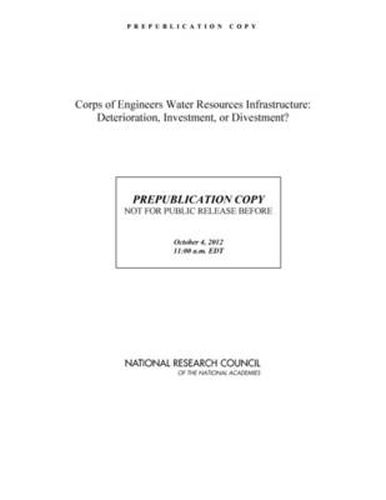Readings Newsletter
Become a Readings Member to make your shopping experience even easier.
Sign in or sign up for free!
You’re not far away from qualifying for FREE standard shipping within Australia
You’ve qualified for FREE standard shipping within Australia
The cart is loading…






Over the past century, the U.S. Army Corps of Engineers has built a vast network of water management infrastructure that includes approximately 700 dams, 14,000 miles of levees, 12,000 miles of river navigation channels and control structures, harbors and ports, and other facilities. Historically, the construction of new infrastructure dominated the Corps’ water resources budget and activities. Today, national water needs and priorities increasingly are shifting to operations, maintenance, and rehabilitation of existing infrastructure, much of which has exceeded its design life. However, since the mid-1980s federal funding for new project construction and major rehabilitation has declined steadily. As a result, much of the Corps’ water resources infrastructure is deteriorating and wearing out faster than it is being replaced. Corps of Engineers Water Resources Infrastrucutre: Deterioration, Investment, or Divestment? explores the status of operations, maintenance, and rehabilitation of Corps water resources infrastructure, and identifies options for the Corps and the nation in setting maintenance and rehabilitation priorities.
$9.00 standard shipping within Australia
FREE standard shipping within Australia for orders over $100.00
Express & International shipping calculated at checkout
Over the past century, the U.S. Army Corps of Engineers has built a vast network of water management infrastructure that includes approximately 700 dams, 14,000 miles of levees, 12,000 miles of river navigation channels and control structures, harbors and ports, and other facilities. Historically, the construction of new infrastructure dominated the Corps’ water resources budget and activities. Today, national water needs and priorities increasingly are shifting to operations, maintenance, and rehabilitation of existing infrastructure, much of which has exceeded its design life. However, since the mid-1980s federal funding for new project construction and major rehabilitation has declined steadily. As a result, much of the Corps’ water resources infrastructure is deteriorating and wearing out faster than it is being replaced. Corps of Engineers Water Resources Infrastrucutre: Deterioration, Investment, or Divestment? explores the status of operations, maintenance, and rehabilitation of Corps water resources infrastructure, and identifies options for the Corps and the nation in setting maintenance and rehabilitation priorities.